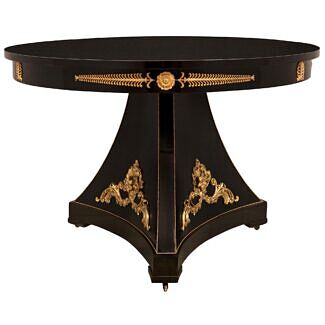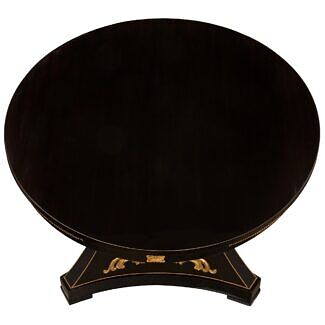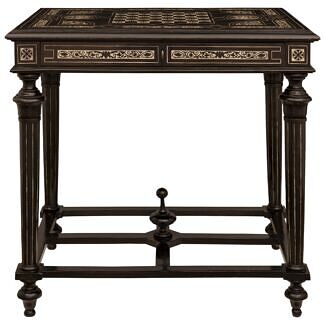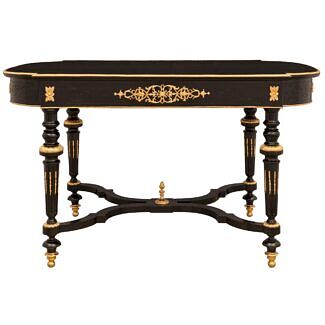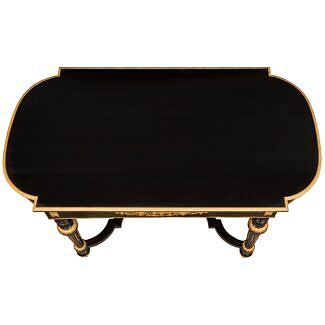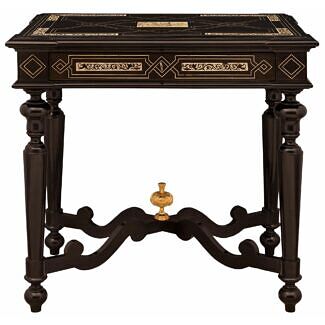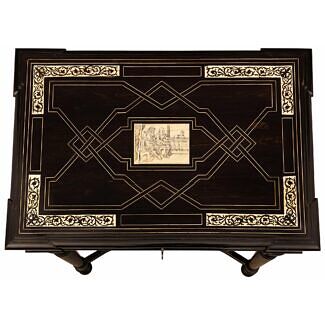A French 19th century Louis XVI st. Ebony and Ormolu Boulle side/center table
An impressive and most elegant French 19th century Louis XVI st. Ebony and Ormolu Boulle side/center table. This wonderful table is raised on four round tapered and fluted Ebony legs with casters while being connected by a squared 'X' stretcher.... — Read More
An impressive and most elegant French 19th century Louis XVI st. Ebony and Ormolu Boulle side/center table. This wonderful table is raised on four round tapered and fluted Ebony legs with casters while being connected by a squared 'X' stretcher. At the center is an Ormolu urn which is tastefully decorated with foliate designs, beaded bands, and scrolling handles. Ormolu chandelles decorate the top and bottom of each leg and lead to Ormolu foliate top caps. The straight front apron showcases an Ormolu berried laurel band at the base and detailed panels above. The panel displays an Ormolu reserve of intertwined patterns separated by fluted patterns all within a mottled rectangular band. The panel is flanked by weaving and tapered Ormolu patterns accented by scrolls that are encased with Boulle designs of Brass inlays. The two curved side aprons are designed similarly with their Ormolu berried laurel bands and rectangular Brass Boulle inlays. The uniquely shaped top is edged with an Ormolu band displaying Coeur-de-Rai designs that surrounds the perfectly finished Ebony top. — Read Less
- Item # 3877
-
H: 27.5 in L: 37.5 in D: 20.75 in
H: 70 cm L: 95 cm D: 53 cm
- France
- 19th Century
- Brass, Ebony, Ormolu
-
Louis XVI st. Read More
(Louis XVI st.) -
Also known as Louis Seize, Louis XVI's style is a style of architecture, furniture, decoration, and art created during Louis XVI’s 19-year reign in France, just before the French Revolution.
Thought to be a reaction and juxtaposition to the prior more elaborate styles, Louis XVI style developed at the end of the Baroque Period and continued until the birth of French Neoclassicism.
King Louis XVI showed little enthusiasm for the old world styles of the Baroque Period and he sought out a create a new “beau ideal” that focused on the purity and grandeur of Ancient Romans and Greeks.
Inspired by Ancient Roman architecture and art, distinct features of the Louis XVI style are linear lines, small repeated motifs, floral medallions hanging from ribbons, acanthus leaves, urns, dolphins, ram, and lion heads, and griffins.
Greco-Roman elements, often used in earlier and later French styles, were also quick common and included fluted and twisted columns, Caryathids, and corbels.
- André-Charles Boulle Read More
He was the French cabinetmaker considered to be the preeminent artist in the field of marquetry, even called the most remarkable of all French cabinetmakers. Boulle was renowned as the leading cabinet-maker of French furniture in the 17th and 18th century. His fame in marquetry led to his name being given to the fashion he perfected of inlaying brass and tortoiseshell, known as Boulle. Boulle was granted lodgings in the galleries of the Louvre, which King Henri IV had set apart for the use of his most favored artists employed by the crown. Boulle received the post of Premier Ébéniste du Roi. Foreign princes and the great nobles, government ministers and financiers of his own country crowded to him with commissions. Boulle's creations included commodes, bureaux, armoires, pedestals, clock cases and lighting-fixtures, richly mounted with gilt-bronze that he modeled himself.
Pointed out to the king by Colbert as “the most skilful in his trade”, Boulle was the author of a large number of pieces of furniture in bronze and marquetry which made him the leading cabinet-maker of French furniture in the 17th and 18th century. The creativity and richness of his pieces of furniture contributed to the reputation of Versailles in this art.
Beginning in 1672, he produced all kinds of pieces of furniture for Louis XIV, his family and the court, and the name of Boulle is inseparable from the copper and tortoiseshell marquetry that made his success: the famous “Boulle marquetry”. Although he was not its inventor, he devised a new process by cutting out patterns from these materials. He thus obtained two panels: the “part” and the “counterpart”. The first was in copper on a background of tortoiseshell, the second in tortoiseshell on a background of copper. In 1684-1692, the Grand Dauphin commissioned in Boulle marquetry the panelling and parquet of his study in Versailles, lost in the 18th century.
Another major innovation of Boulle was the application of bronzes on his pieces of furniture to protect the most fragile parts. Grotesque masks, claws, friezes, foliage patterns, etc. invaded console tables, desks, studies, etc. Bronzes that are also found on clocks, wall-clocks, candelabras, ink-well stands, etc.
The celebrated cabinet-maker did not limit himself to technical or aesthetic innovations, he also created new pieces of furniture. For the bedchamber of Louis XIV at Trianon, he revolutionize in 1708 a type of piece of furniture: the chest of drawers. On exhibition today in Versailles, the two chests of drawers of the king marvellously sum up the art of Boulle: the originality of this piece of furniture in its principle and its shape; marquetry of copper and tortoiseshell and an abundance of bronze details. Moreover, they are the rare pieces of furniture identifiable from his immense production. Boulle also made for the king large flat standing desks, salon tables, jewellery caskets, monumental pendulum clocks, etc.
The beauty and perfection of his pieces of furniture earned him immense celebrity in France and in Europe: Philippe V of Spain and Maximilian-Emmanuel of Bavaria were part of his prestigious clientele. Paradoxically, Boulle was often in financial difficulty: the king had to intervene on several occasions to protect him from his creditors. He went out of fashion after his death in 1732, but his pieces of furniture were reproduced with success in the mid-18th century and especially during the Second Empire.
Payment Plan Option Learn More Choose the payment plan option at checkout and customize this payment option with our team. Payment plans are flexible and items will ship once all payments are received.






















